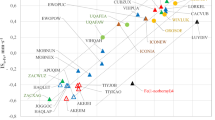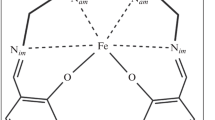Abstract
Analysis of the available experimental data on iron compounds has shown the following:
The 57Fe Mössbauer isomer shift (IS) depends on the average interatomic distance between the iron ion and the ions of its first coordination sphere (aID), on the chemical nature of these ions, and also on the iron coordination number. An increase in aID and a decrease in the coordination number lead to an increase in IS. For a given polyhedron, the correlation between IS and aID is close to linear with a slope of about 0.04 mm⋅s-1⋅pm-1. A change in the oxidation state of iron (OSFe) affects IS, since a change in OSFe causes a change in aID due to a change in the number of electrons on the valence shell of iron; the more OSFe, the less IS. If the aID of differently charged ions are close (e.g., for the pair H4[Fe(CN)6] and H3[Fe(CN)6]), then the IS values do not differ significantly. A change in the spin state of an iron ion affects IS insofar as this change causes a change in aID. In particular, the transition from the high-spin to the low-spin state in iron(II) spin-crossover compounds leads to a decrease in aID and, accordingly, to a decrease in IS. A change in the spatial structure of the iron coordination polyhedron may affect IS. This was observed when comparing tetrahedral and square-planar iron(II) oxygen polyhedra. The tetrahedral and square-planar oxygen polyhedra of high-spin iron(II) show increased IS values. In terms of the orbital model of the electron shell of the atom, the above data can be explained by the interactions of the 4s-orbital of iron with its other valence orbitals (undergoing hybridization), as well as with the orbitals of the ions surrounding iron (establishing directional chemical bonds). These interactions affect the electron density at the iron nucleus. The corresponding contributions depend on the distances between the iron ion and the ions surrounding it, but do not depend on the number of orbitals involved into hybridization or on the number of directional chemical bonds. The electron shell of each ion of the iron polyhedron also makes an additional (non-bonding) contribution to the electron density at the iron nucleus. In some specific cases (e.g., for iron in noble gas matrices), the observed unusually low IS can be explained by the filling of the 4s-orbital of iron with its valence non-bonding electron(s).
Similar content being viewed by others
References
Bianchi, C.L., et al.: Can.J.Chem. Eng. 99, 2105 (2021)
Kamnev, A.A., Tugarova, A.V.: Russ.Chem.Rev. 90, 1415 (2021)
Maksimova, A.A., et al.: Minerals. 11, 614 (2021)
Modern Mӧssbauer Spectroscopy / Eds. Y. Yoshida, G. Langouche, Springer 2021, 523p.
Hoppe, R., Mader, K.: Z.Anorg.Allg.Chem. 586, 115 (1990)
Perfiliev, Yu.D., et al.: Russ.J.Inorg.Chem. 45,1568 (2000)
Dedushenko, S.K., et al.: Hyp.Int. 185, 197 (2008)
Dedushenko, S.K., et al.: Hyp.Int. 136/137, 373 (2001)
Jeannot, C., et al.: J.Solid State Chem. 165, 266 (2002)
Delattre, J.L., et al.: Inorg.Chem. 41, 2834 (2002)
Kessler, H., Son, L.: Rev.Chim.Miner. 17, 541 (1980)
Hoch, C., et al.: Z.Naturforsch. B 66, 441 (2011)
Dedushenko, S.K., Perfiliev, Yu.D.: Bull.Russ.Acad.Sci.Physics 81, 793 (2017)
Ojima, K.Y., et al: Acta Cryst. B 51, 287 (1995)
Gonzalez-Silgo, C., et al.: Ferroelectrics 177, 191 (1996)
Menil, F.: J.Phys.Chem.Solids 46, 763 (1985)
Walker, L.L., et al.: Phys.Rev.Let. 6, 98 (1961)
Birchall, T., Greenwood, N.N.: J.Chem.Soc. (A), 2382 (1969)
Collins, D.W., Mulay, I.N.: J.Am.Cer.Soc. 53, 74 (1970)
Tsujimoto, Y., et al.: Nature 450, 1062 (2007)
Kageyama, H., et al.: Angew.Chem.Int.Ed. 47, 5740 (2008)
Tassel, C., et al.: Inorg.Chem. 52, 6096 (2013)
Robbins, M., et al.: J.Phys.Chem.Solids 32, 717 (1971)
Larsson, L., et al.: Eur.J.Mineral. 6, 39 (1994)
Gallagher, P.K., et al.: J.Chem.Phys. 41, 2429 (1964)
Takano, M., et al.: Mat.Res.Bull. 12, 923 (1977)
Bouchard, R.J., et al.: J.Solid State Chem. 21, 135 (1977)
Dann, S.E., et al.: J.Mater.Chem. 3, 1231 (1993)
Demazeau, G., et al.: Mat.Res.Bull. 16, 1465 (1981)
Hamada, M., et al.: Phys.Rev. B 93, 155165 (2016)
Fock, J., et al.: J.Phys. D: Appl.Phys. 50, 265005 (2017)
Murad, E.: Amer.Mineral. 69, 722 (1984)
Clark, M.G., et al.: J.Chem.Phys. 47, 4250 (1967)
Murad, E., Wagner, F.E.: Phys.Chem.Miner. 14, 264 (1987)
Soubeyroux, J.L., et al.: J.Solid State Chem. 31, 313 (1980)
Strauss, F., et al.: Inorg.Chem. 55, 12775 (2016)
Pinkert, D., et al.: Chem.Commun. 53, 8081 (2017)
De Grave, E., Wandenberghe, R.E.: Phys.Chem.Miner. 17, 344 (1990)
Takeda, Y., et al.: Mat.Res.Bull. 29, 659 (1994)
Turner, S.S., et al.: Magnetochemistry 7, 72 (2021)
Fei, B., et al.: Inorg.Chem.Front. 5, 1671 (2018)
Kucheriv, O.I., et al.: Inorg.Chem. 55, 4906 (2016)
Milek, M., et al.: Inorg,Chem. 52, 11585 (2013)
Belonska, A., et al.: Inorg,Chem. 49, 11267 (2010)
Reger, D.L., et al.: Inorg,Chem. 48, 9393 (2009)
Milocco, F., et al.: Inorg.Chem. 60, 2045 (2021)
Travieso-Puente, R., et al.: JACS 138, 5503 (2016)
Jansen, N., et al.: Angew.Chem.Int.Ed. 31, 1624 (1992)
Indris, S., et al.: Eur.J.Inorg.Chem. 2021, 951 (2021)
Werncke, C.G., et al.: Angew.Chem. 53, 1 (2014)
Konig, S.N., et al.: Eur.J.Inorg.Chem. 2014, 4302 (2014)
Long, G.J., et al.: Inorg.Chem. 54, 8415 (2015)
Patra, A.K., et al.: Inorg.Chem. 49, 2032 (2010)
MacDonnell, F.M., et al.: Inorg.Chem. 34, 1815 (1995)
Ellison, J.J., et al.: Angew.Chem. 33, 1178 (1994)
Power, P.P., Shoner, S.C.: Angew.Chem. 30, 330 (1991)
Li, G., et al.: Chem.Mater. 26, 5821 (2014)
Bronger, W., Ruschewitz, U.: J.Alloys.Compd. 197, 83 (1993)
Ensling, J., et al.: Hyp.Int. 28, (1986)
Riedel, E., Karl, R.: J.Solid State Chem. 35, 77 (1980)
Evans, B.J., et al.: Geochim.Cosmochim.Acta 46, 761 (1982)
Lemley, J.T., et al.: J.Solid State Chem. 16, 117 (1976)
Garg, A.N., Goel, P.S.: J.Inorg.Nucl.Chem. 32, 1547 (1970)
Garg, A.N., Goel, P.S.: J.Inorg.Nucl.Chem. 31, 6977 (1969)
Zadrozny, J.M., et al.: Nat.Chem. 5, 577 (2013)
LaPointe, A.M.: Inorg.Chim.Acta 345, 359 (2003)
Yamada, Y., et al.: Chem.Phys.Let. 567, 14 (2013)
Micklitz, H., Barret, P.H.: Phys.Rev.Let. 28, 1547 (1972)
Long, G.J., et al.: JACS 120, 12163 (1998)
Kantor, I., et al.: Phys.Chem.Miner. 33, 35 (2006)
Kantor, I.Yu., et al.: Phys.Rev. B 73, 100101 (2006)
Yaremchenko, A.A., et al.: Sol.St.Ion. 192, 252 (2011)
Author information
Authors and Affiliations
Corresponding author
Additional information
Publisher’s note
Springer Nature remains neutral with regard to jurisdictional claims in published maps and institutional affiliations.
This article is part of the Topical Collection on Proceedings of the International Conference on the Applications of the Mössbauer Effect (ICAME 2021), 5-10 September 2021, Brasov, Romania
Edited by Victor Kuncser
Supplementary Information
ESM 1
(DOCX 13 kb)
Rights and permissions
About this article
Cite this article
Dedushenko, S.K., Perfiliev, Y.D. On the correlation of the 57Fe Mӧssbauer isomer shift and some structural parameters of a substance. Hyperfine Interact 243, 15 (2022). https://doi.org/10.1007/s10751-022-01795-1
Accepted:
Published:
DOI: https://doi.org/10.1007/s10751-022-01795-1




